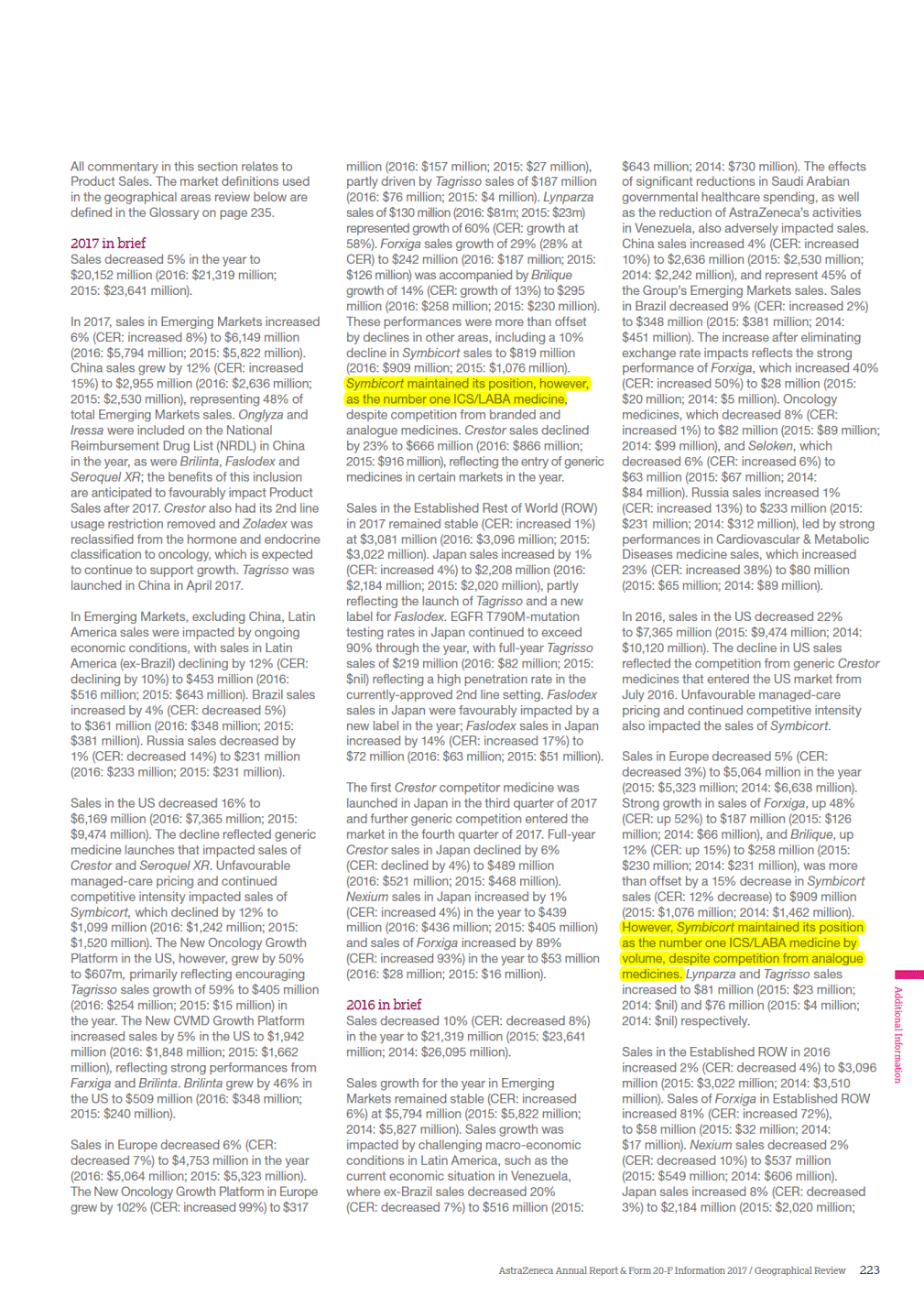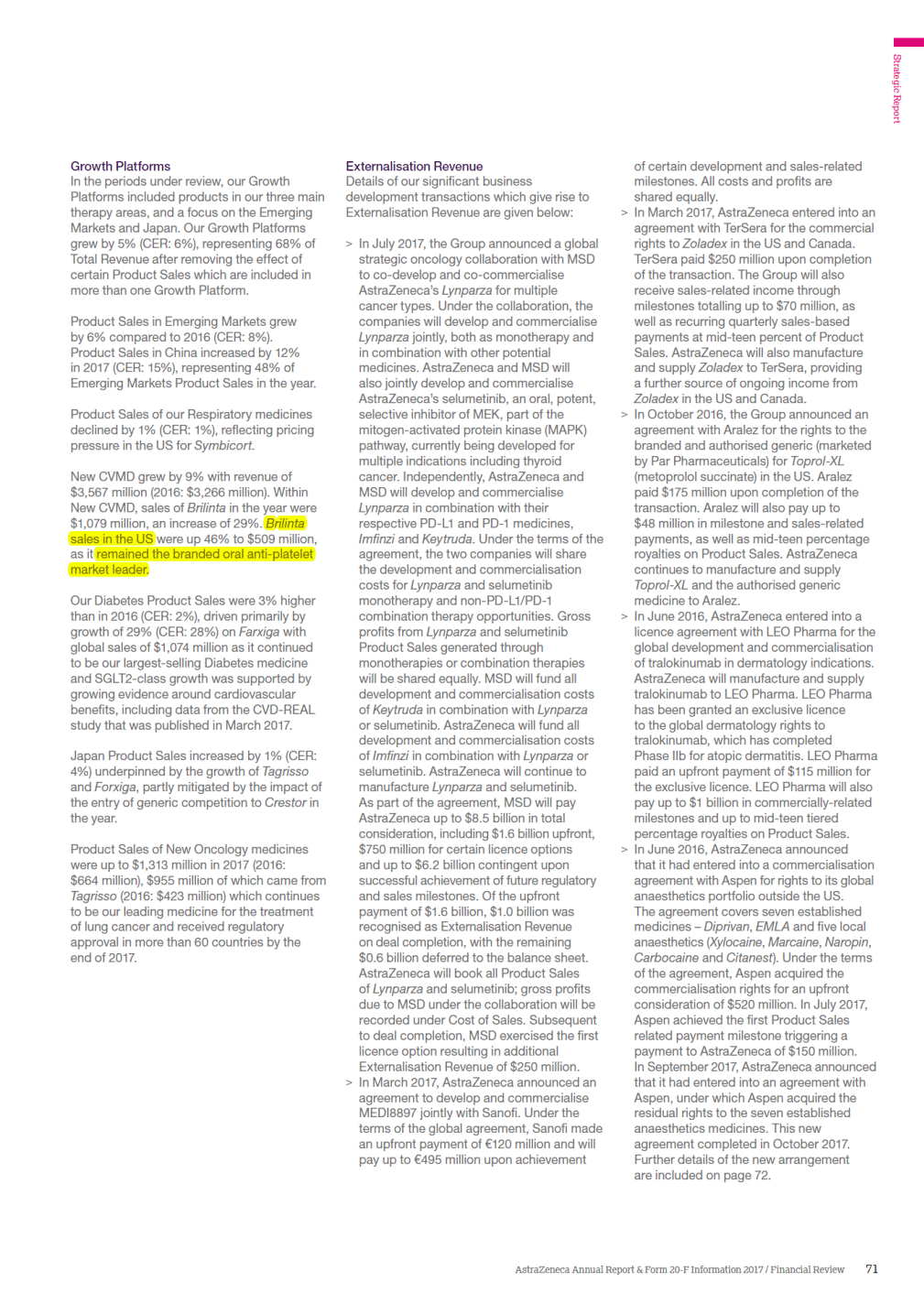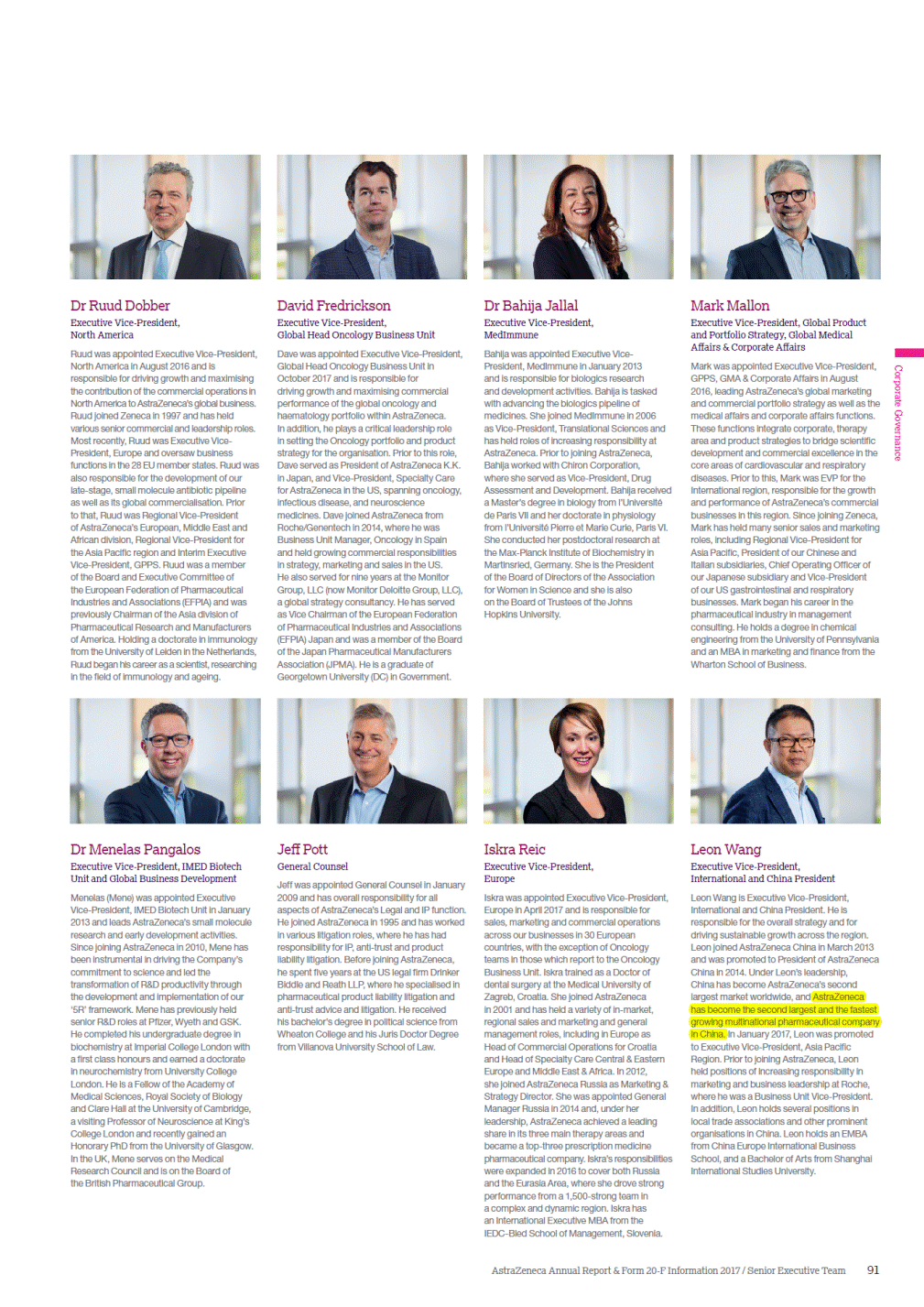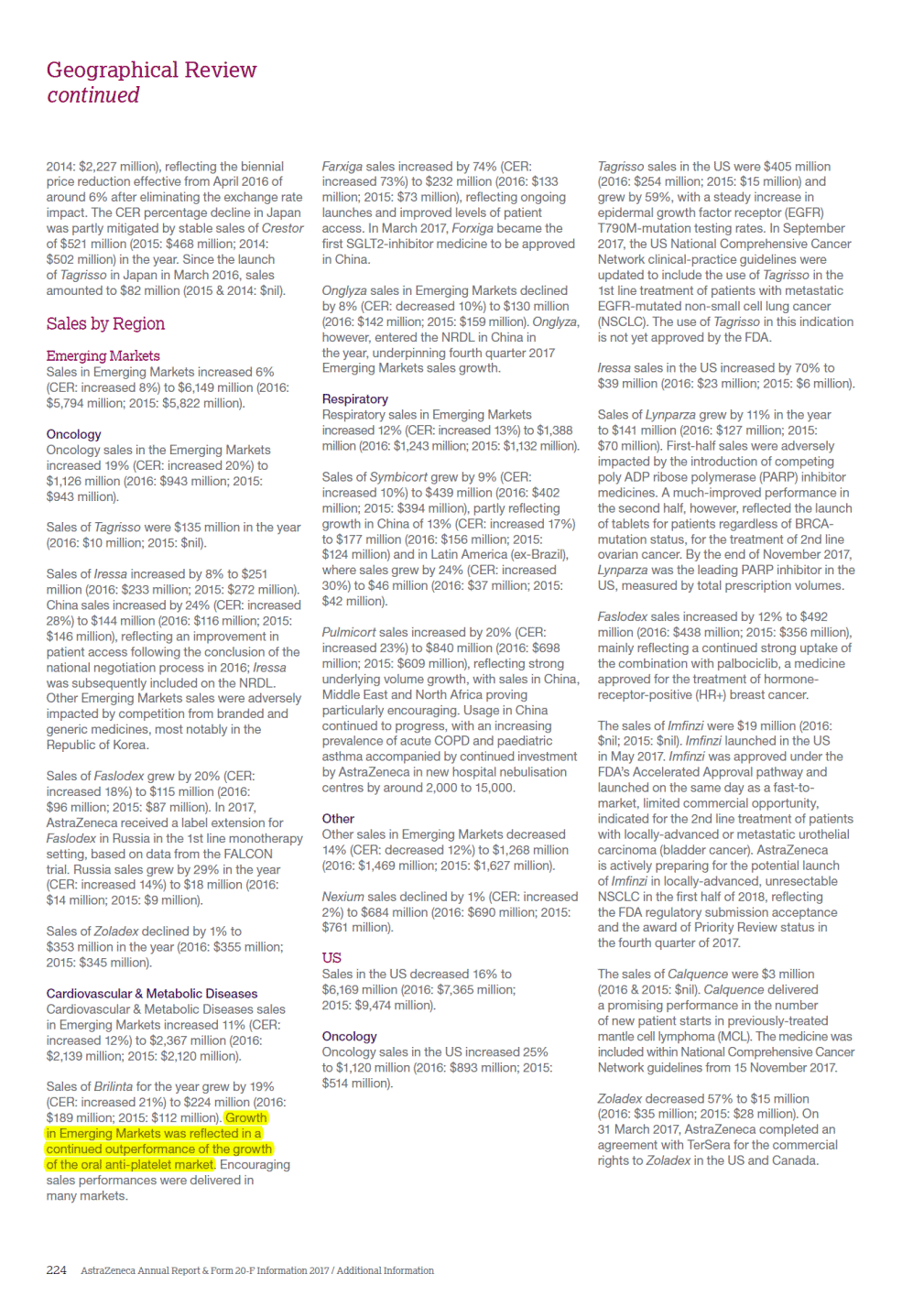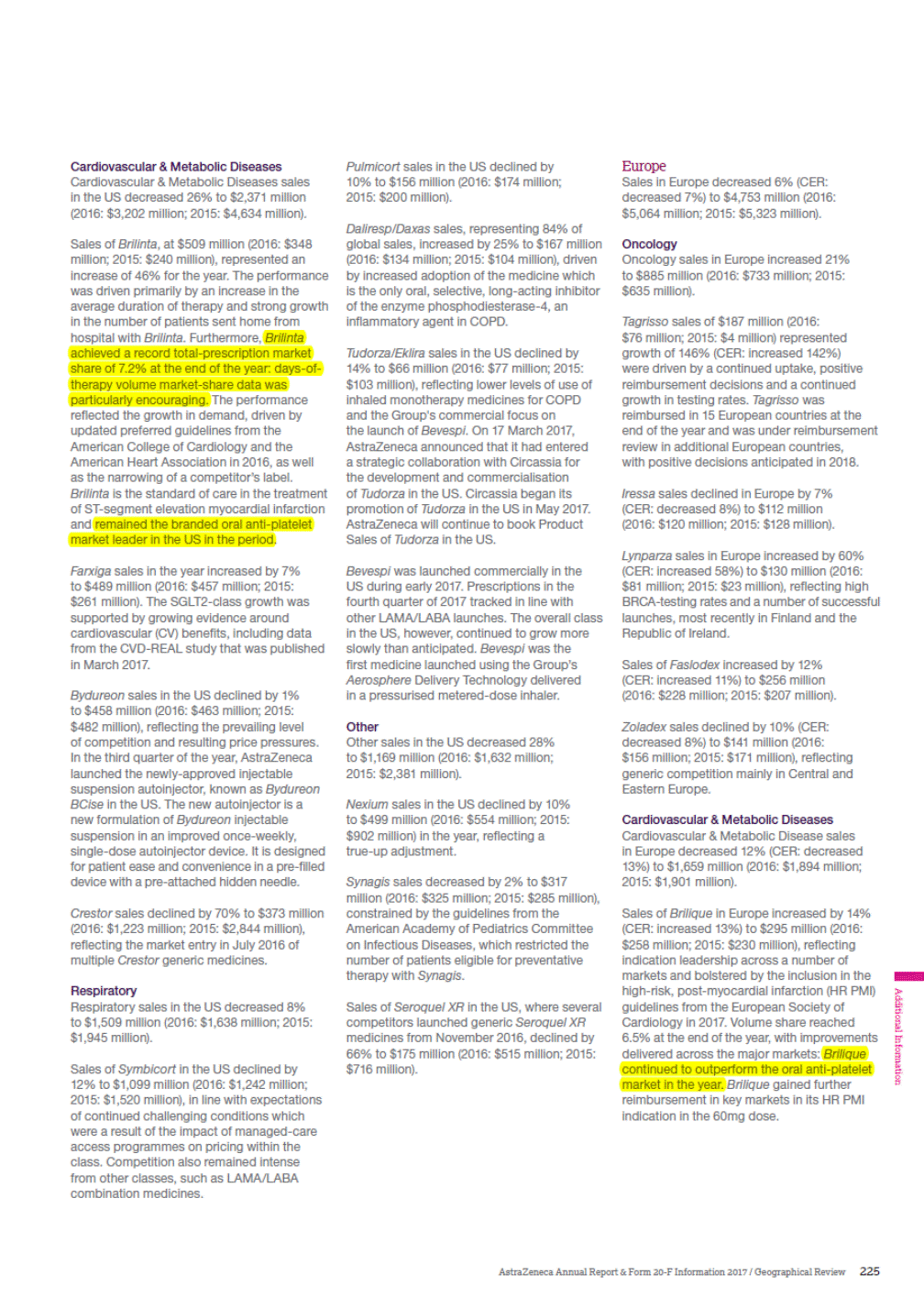All commentary in this section relates to Product Sales. The market definitions used in the geographical areas review below are defined in the Glossary on page 235. million (2016: $157 million; 2015: $27 million), partly driven by Tagrisso sales of $187 million (2016: $76 million; 2015: $4 million). Lynparza sales of $130 million (2016: $81m; 2015: $23m) represented growth of 60% (CER: growth at 58%). Forxiga sales growth of 29% (28% at CER) to $242 million (2016: $187 million; 2015: $126 million) was accompanied by Brilique growth of 14% (CER: growth of 13%) to $295 million (2016: $258 million; 2015: $230 million). These performances were more than offset by declines in other areas, including a 10% decline in Symbicort sales to $819 million (2016: $909 million; 2015: $1,076 million). Symbicort maintained its position, however, as the number one ICS/LABA medicine, despite competition from branded and analogue medicines. Crestor sales declined by 23% to $666 million (2016: $866 million; 2015: $916 million), reflecting the entry of generic medicines in certain markets in the year. $643 million; 2014: $730 million). The effects of significant reductions in Saudi Arabian governmental healthcare spending, as well as the reduction of AstraZeneca’s activities in Venezuela, also adversely impacted sales. China sales increased 4% (CER: increased 10%) to $2,636 million (2015: $2,530 million; 2014: $2,242 million), and represent 45% of the Group’s Emerging Markets sales. Sales in Brazil decreased 9% (CER: increased 2%) to $348 million (2015: $381 million; 2014: $451 million). The increase after eliminating exchange rate impacts reflects the strong performance of Forxiga, which increased 40% (CER: increased 50%) to $28 million (2015: $20 million; 2014: $5 million). Oncology medicines, which decreased 8% (CER: increased 1%) to $82 million (2015: $89 million; 2014: $99 million), and Seloken, which decreased 6% (CER: increased 6%) to $63 million (2015: $67 million; 2014: $84 million). Russia sales increased 1% (CER: increased 13%) to $233 million (2015: $231 million; 2014: $312 million), led by strong performances in Cardiovascular & Metabolic Diseases medicine sales, which increased 23% (CER: increased 38%) to $80 million (2015: $65 million; 2014: $89 million). 2017 in brief Sales decreased 5% in the year to $20,152 million (2016: $21,319 million; 2015: $23,641 million). In 2017, sales in Emerging Markets increased 6% (CER: increased 8%) to $6,149 million (2016: $5,794 million; 2015: $5,822 million). China sales grew by 12% (CER: increased 15%) to $2,955 million (2016: $2,636 million; 2015: $2,530 million), representing 48% of total Emerging Markets sales. Onglyza and Iressa were included on the National Reimbursement Drug List (NRDL) in China in the year, as were Brilinta, Faslodex and Seroquel XR; the benefits of this inclusion are anticipated to favourably impact Product Sales after 2017. Crestor also had its 2nd line usage restriction removed and Zoladex was reclassified from the hormone and endocrine classification to oncology, which is expected to continue to support growth. Tagrisso was launched in China in April 2017. Sales in the Established Rest of World (ROW) in 2017 remained stable (CER: increased 1%) at $3,081 million (2016: $3,096 million; 2015: $3,022 million). Japan sales increased by 1% (CER: increased 4%) to $2,208 million (2016: $2,184 million; 2015: $2,020 million), partly reflecting the launch of Tagrisso and a new label for Faslodex. EGFR T790M-mutation testing rates in Japan continued to exceed 90% through the year, with full-year Tagrisso sales of $219 million (2016: $82 million; 2015: $nil) reflecting a high penetration rate in the currently-approved 2nd line setting. Faslodex sales in Japan were favourably impacted by a new label in the year; Faslodex sales in Japan increased by 14% (CER: increased 17%) to $72 million (2016: $63 million; 2015: $51 million). In Emerging Markets, excluding China, Latin America sales were impacted by ongoing economic conditions, with sales in Latin America (ex-Brazil) declining by 12% (CER: declining by 10%) to $453 million (2016: $516 million; 2015: $643 million). Brazil sales increased by 4% (CER: decreased 5%) to $361 million (2016: $348 million; 2015: $381 million). Russia sales decreased by 1% (CER: decreased 14%) to $231 million (2016: $233 million; 2015: $231 million). In 2016, sales in the US decreased 22% to $7,365 million (2015: $9,474 million; 2014: $10,120 million). The decline in US sales reflected the competition from generic Crestor medicines that entered the US market from July 2016. Unfavourable managed-care pricing and continued competitive intensity also impacted the sales of Symbicort. Sales in Europe decreased 5% (CER: decreased 3%) to $5,064 million in the year (2015: $5,323 million; 2014: $6,638 million). Strong growth in sales of Forxiga, up 48% (CER: up 52%) to $187 million (2015: $126 million; 2014: $66 million), and Brilique, up 12% (CER: up 15%) to $258 million (2015: $230 million; 2014: $231 million), was more than offset by a 15% decrease in Symbicort sales (CER: 12% decrease) to $909 million (2015: $1,076 million; 2014: $1,462 million). However, Symbicort maintained its position as the number one ICS/LABA medicine by volume, despite competition from analogue medicines. Lynparza and Tagrisso sales increased to $81 million (2015: $23 million; 2014: $nil) and $76 million (2015: $4 million; 2014: $nil) respectively. The first Crestor competitor medicine was launched in Japan in the third quarter of 2017 and further generic competition entered the market in the fourth quarter of 2017. Full-year Crestor sales in Japan declined by 6% (CER: declined by 4%) to $489 million (2016: $521 million; 2015: $468 million). Nexium sales in Japan increased by 1% (CER: increased 4%) in the year to $439 million (2016: $436 million; 2015: $405 million) and sales of Forxiga increased by 89% (CER: increased 93%) in the year to $53 million (2016: $28 million; 2015: $16 million). Sales in the US decreased 16% to $6,169 million (2016: $7,365 million; 2015: $9,474 million). The decline reflected generic medicine launches that impacted sales of Crestor and Seroquel XR. Unfavourable managed-care pricing and continued competitive intensity impacted sales of Symbicort, which declined by 12% to $1,099 million (2016: $1,242 million; 2015: $1,520 million). The New Oncology Growth Platform in the US, however, grew by 50% to $607m, primarily reflecting encouraging Tagrisso sales growth of 59% to $405 million (2016: $254 million; 2015: $15 million) in the year. The New CVMD Growth Platform increased sales by 5% in the US to $1,942 million (2016: $1,848 million; 2015: $1,662 million), reflecting strong performances from Farxiga and Brilinta. Brilinta grew by 46% in the US to $509 million (2016: $348 million; 2015: $240 million). 2016 in brief Sales decreased 10% (CER: decreased 8%) in the year to $21,319 million (2015: $23,641 million; 2014: $26,095 million). Sales in the Established ROW in 2016 increased 2% (CER: decreased 4%) to $3,096 million (2015: $3,022 million; 2014: $3,510 million). Sales of Forxiga in Established ROW increased 81% (CER: increased 72%), to $58 million (2015: $32 million; 2014: $17 million). Nexium sales decreased 2% (CER: decreased 10%) to $537 million (2015: $549 million; 2014: $606 million). Japan sales increased 8% (CER: decreased 3%) to $2,184 million (2015: $2,020 million; Sales growth for the year in Emerging Markets remained stable (CER: increased 6%) at $5,794 million (2015: $5,822 million; 2014: $5,827 million). Sales growth was impacted by challenging macro-economic conditions in Latin America, such as the current economic situation in Venezuela, where ex-Brazil sales decreased 20% (CER: decreased 7%) to $516 million (2015: Sales in Europe decreased 6% (CER: decreased 7%) to $4,753 million in the year (2016: $5,064 million; 2015: $5,323 million). The New Oncology Growth Platform in Europe grew by 102% (CER: increased 99%) to $317 AstraZeneca Annual Report & Form 20-F Information 2017 / Geographical Review 223 Additional Information
